
In the shadow of looming threats to global food security, the nexus of water scarcity and economic stability has received increasing attention over the past decade (Elliott et al., 2014; D’Odorico et al., 2018; Rosa et al., 2020). Water bodies and aquifers are depleted in many parts of the world (Elliott et al., 2014), with agricultural irrigation accounting for about 70% of this depletion (Wallace, 2000). Compounded by the swings of a changing climate, traditionally predictable rhythms of rain-fed croplands are being disrupted (Rosa et al., 2020). A growing population under a changing climate creates an urgent need for the expansion of irrigation to meet the demands from food production, which in turn raises concerns about the sustainability of agricultural systems given limited freshwater resources (Rockström et al., 2012).
In response to declining availability of fresh water derived from groundwater and surface water bodies, many industries are exploring alternative sources to meet their water needs and reduce their reliance on fresh water. Examples of such substitution involve seawater, rainfall, brackish water, non-freshwater surface water, and reclaimed water. Reclaimed water is typically defined as wastewater recovered from domestic, commercial, industrial, and other sources, which is treated to remove impurities so that it can be reused (Braune et al., 2021). Reclaimed water can help relieve the pressure on freshwater demand. It can provide a sustainable source of water for industrial, agricultural and even potable uses, often with lower investment costs and energy consumption than some alternative water sources such as desalinated water or interbasin water diversion.
The terms “recycled,” “reused,” and “reclaimed” are often used interchangeably; however, subtle semantic differences and practical considerations can lead analysts to favor one term over another. For example, the Irrigation and Water Management Survey (IWMS) by the National Agricultural Statistics Service (NASS) differentiates between “recycled water” and “reclaimedwater.” In their terminology, recycled water refers to irrigation water that has been previously used on a crop within the same operation, whereas reclaimed water is treated wastewater from various sources that is later used for irrigation (USDA-NASS, 2018). The WateReuse Association considers “reused” and “recycled” to be synonymous terms, distinct from “reclaimed” water. They assert that reclaimed water only becomes “reused” or “recycled” once it is applied to a specific purpose (WateReuse Association, 2023). While California consistently uses the term “recycled” water, Florida prefers “reclaimed” water to describe treated wastewater used for another purpose (Sheikh et al., 2018). In this article, we will use the term “reclaimed water” for consistency with its widespread use in the state of Florida and emphasis on the treated nature of water before it is applied to a specific use.
According to a study released by the Center for Public Issues Education at the University of Florida, Floridians rank water as the second most “important or extremely important” issue in the state, after health care (Yilin, 2018). Citizens’ awareness has grown steadily as the water resources in the state face increased pressure. With the nation’s third-largest population, Florida is the fastest growing state in the country, gaining approximately 1 million new residents every 3 years (Perry, Rogers, and Wilder, 2022). Increasing population speeds up the development and urbanization processes in the state, affecting the available water supply (FDEP, 2020a). According to some estimates, Florida may need as much as an additional 300 million gallons of water a day over the next 20 years to meet the needs of its growing population (Lusk, 2017).
In Florida, reclaimed water use plays a vital role for the statewide water resource management to reduce the pressure on potable water supplies. The Florida Legislature has established “the encouragement and promotion of reuse of reclaimed water and water conservation” as formal state objectives in Sections403.064(1) and 373.250 of the Florida Statutes.
In 2020, Florida used approximately 884 million gallons per day (mgd) of reclaimed water. This reduced the use of 430 mgd of potable-quality water. Total water reused per day and per capita was 37.92 gallons (FDEP, 2020b), which represents a significant portion (32%) of the statewide average water supply per capita of 118.7 gallons per capita per day. This average was calculated by the authors across the five Florida regional water management districts for the fiscal year 2019–2020, based on data from the Florida Department of Environmental Protection (FDEP, 2020b).
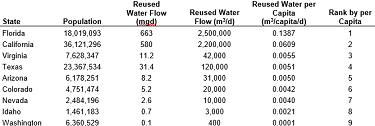
Table 1 shows the daily reclaimed water use in different U.S. states in 2015 (Sheikh et al., 2018). Florida ranks first among U.S. states in total annual water reuse, followed closely by California. The per capita use of reclaimed water in Florida is more than twice that in California. Aggregated total water reuse by all the other states is noticeably lower than that in either Florida or California.
Aside from rapidly increasing population and legislative mandates for surface water conservation, other factors have forced Floridians to consider reclaimed water as an alternative water source. The threat of climate change to the crucial Floridan aquifer, a key source of the state’s drinking water, adds urgency to freshwater preservation efforts (Parsons, 2018). The state’s scarcity of fast-flowing rivers to disperse wastewater, coupled with the tourism industry’s reliance on pristine water bodies, underscores the need for alternative water sources. Further, rapidly growing parts of the state face limited groundwater availability, which is susceptible to overuse and saltwater intrusion, further encouraging the pursuit for sustainable water solutions.
Globally, agriculture dominates water usage, consuming 70% of all water withdrawals, primarily for irrigation (Braune et al., 2021). In Florida, this trend contributes to the state’s robust agricultural economy, which garnered over $4 billion from exports in 2015, making it thenation’s seventh-largest agricultural exporter (Borisova et al., 2019). Reflecting its economic significance, agriculture ranks as Florida’s second-largest consumer of freshwater, drawing 2,089 mgd in the same year (Marella and Dixon, 2018). As of 2020, irrigation was utilized on nearly a quarter of Florida’s agricultural land, spanning almost 2 million acres, with the most extensive areas located in the South and Southwest Florida Water Management Districts (Florida Department of Agriculture and Consumer Services, 2022). Notably, crops such as sugarcane, citrus, and vegetables were the primary consumers of agricultural water, followed by greenhouse and nursery plants, field crops, and hay (Borisova et al., 2019). This substantial water need in agriculture underscores the critical role of more sustainable water management in supporting Florida’s economy and environmental resources.
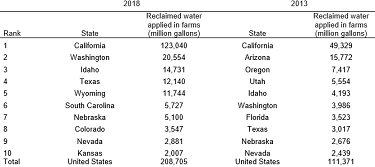
Agriculture is by far the largest consumer of water, yet it uses a relatively small percentage of the total reclaimed water in most regions (Sheikh et al., 2018). Table 2 ranks the top 10 states using reclaimed water for agricultural irrigation in the United States, with California leading the way in 2018. Florida ranked seventh in 2013, using 3,523 million gallons, but its use of reclaimed water in agriculture dropped to 249 million gallons by 2018, pushing it out of the top 10. Figure 1 depicts Florida’s varied uses of reclaimed water from 1996 to 2020 (FDEP, 2020b). In 1996, agricultural irrigation represented 24% (92 mgd) of the 390 mgd reuse flow. Public access areas (i.e., areas open to public at largesuch as golf courses, cemeteries, parks, landscape areas, hotels, motels, and highway medians as well as areas that are not open to the public at large, including private property and residential dwellings) used 161 mgd, accounting for 41% of the daily reuse flow. Since then, the usage for public access areas and landscape irrigation has increased more than fourfold to 563 mgd, while use in agricultural irrigation declined to 53 mgd.
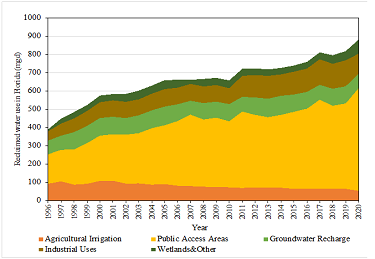
Figure 2 shows that the total flow of reclaimed water in Florida has increased over time, with public access areas accounting for 64% of the total flow, compared to agriculture’s 6% share in the total flow of reclaimed water (FDEP, 2020b). This shows an active use of reclaimed water in cities, with non agricultural users being closer to water sources. Cities and industries are incentivized to use reclaimed water by a larger potable quality water offset (i.e., the amount of potable quality water saved by reclaimed water) (FDEP, 2020b). An increase in urban recycling might have led to a decreased share of reclaimed water for agriculture in Florida (Figure 1). Additionally, a reduction in water consumption for certain high-use crops may further explain the lower percentage of reclaimed water used in agriculture. This hypothesis is explored further in the subsequent section.
About 79% of reclaimed water flow for reused for agriculture has been used to irrigate citrus in Florida, one of the leading crops produced in the state (Parsons, 2018). Over the past 20 years, however, citrus production and acreage have declined due to hurricanes, real estate development, and disease(Parsons, 2018). Two major citrus diseases—citrus canker and greening—have exacerbated the reduction incitrus. Huanglongbing, or greening, is spread by insects called psyllids and causes trees to decay and eventually die. No cure has been found for this disease, which is currently decimating Florida’s citrus industry (Singerman, Lence, and Useche, 2017).
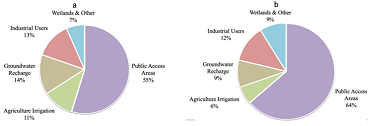
Figure 3 contains geographical data on county-level citrus production (in 1,000 boxes), along with agricultural use of reclaimed water in each of the counties in Florida in 2000 (Figure 3a) and 2020 (Figure 3b). The darker shades correspond to Florida counties with higheragricultural flow of reclaimed water. The orange circles correspond to citrus production in each of the counties, with larger circles representing larger production. According to the annual reclaimed water reuse report from the Florida Department of Environmental Protection (FDEP, 2020b), about half of Florida counties have reused water in agricultural irrigation. In 2000, the counties with the highest usage of reclaimed water in agricultural irrigation were Orange (30.6 mgd), Leon (17.7 mgd), and Okeechobee (9.9 mgd) Counties. In 2020, the counties with the highest usage of reclaimed water in agricultural irrigation were Leon (16.2 mgd), Manatee (5.6 mgd), and Marion (4.1 mgd) Counties. Counties with the highest citrus production in 2000 were Hendry, Polk, and Highlands Counties, with a range of 28.2 to 36.3 million boxes. In contrast, in 2020, the highest citrus production was in Polk County, with only 9.9 million boxes. The total citrus production declined by nearly 80% in the last 20 years. Because the greening disease has caused major tree and production loss, some growers have abandoned their groves. An estimated 130,684 acres of citrus groves have been abandoned (USDA, 2016). Over time, it appears that the reclaimed water used in irrigation of citrus crops declined along with the production and acreage lost to citrus greening.
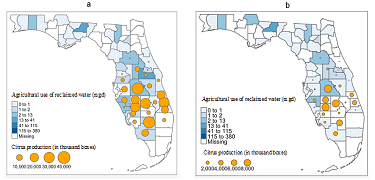
To quantify the associations between yearly changes in agricultural reclaimed water flow and changes in potential drivers of reclaimed water used in agriculture, we use state-level data extracted from the Annual Reuse Water Reports between 1996 and 2020 to employ a multivariate linear regression model (Table 3). Regression results in Table 3 show that decreased use of reclaimed water in the agricultural sector is strongly associated with diminished citrus production in Florida. Citrus production is measured in 1,000 boxes per acre of citrus-bearing areas. The significant coefficient of 0.101 indicates that a citrus production decrease of 1,000 boxes per acre is associated with a decrease in reclaimed water flow into agriculture by 0.101 mgd, holding other factors constant. In addition, there is a significant and positive relationship between state’s total farmland acreage and the use of reclaimed water in the agricultural sector. The coefficient of 0.013 indicates that a reduction of 1,000 acres of farmland would reduce 0.013 mgd of reclaimed water flow into agriculture

(i.e., 1,300 gallons of reclaimed irrigation water reduced perday for each 100 acres of farmland reduction in Florida). Total farmland decreased by 1 million acres from 1996 to 2019 in Florida (USDA, 2022) because of the devastation caused by greening and urban pressure on agricultural lands, which, in turn, contributed to the reduction in reclaimed water use in Florida agriculture. The agricultural sector’s reduced reliance on reclaimed water likely redirected its usage to other areas, notably public access areas and industrial sectors where it has seen an uptick. Changes in other economic variables, including net farm income and irrigation cost, did not significantly change Florida’s agricultural utilization of reclaimed water over time (Table 3).
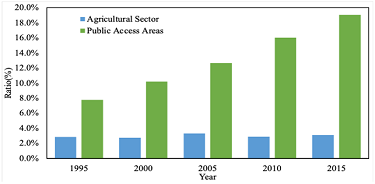
Both reclaimed water and freshwater use declined in Florida’s agricultural sector. According to the water use database (USGS, 2019), the freshwater used in agricultural irrigation declined by 36%, from 0.30 mgdper 1,000 acres in 1995 to 0.22 mgd per 1,000 acres of farmland in 2015. Reclaimed water flow into farmland decreased along with freshwater irrigation in agriculture. In 1995, agricultural irrigation using reclaimed water was 0.0086 mgd per 1,000 acres of farmland, falling to 0.0067 mgd per 1,000 acres of farmland in 2015.
Figure 4 reveals a consistently modest ratio of reclaimed to freshwater irrigation in Florida agriculture, hovering between 2.8% and 3.3% over time. This steady but low ratio suggests two possibilities. First, there is room to expand the use of reclaimed water in agriculture, offering an untapped resource for irrigation. Meanwhile, the use of reclaimed water in public
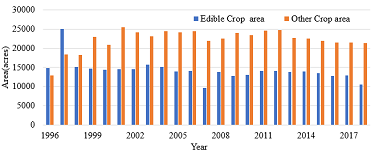
access areas has seen a notable increase, rising from 7.8% in 1995 to 19% in 2015. This may be partially explained by the fact that societal acceptance of reclaimed water is generally higher for nonagricultural purposes than for food production. Low agricultural use of reclaimed water may also be due to stringent Florida regulations on using reclaimed water for crop irrigation, especially for edible crops (Braune et al., 2021). Figure 5 confirms the longstanding lower usage of reclaimed water for edible versus nonedible crops. Additionally, concerns about the safety of using reclaimed water, particularly from human waste, continue to hinder broader acceptance and application in agriculture.
From a positive viewpoint, the consistency of relative reclaimed water use in agriculture (Figure 4) indicates its sustained adoption by Florida’s farmers rather than abandonment over time. A 2010 survey for the Southwest Florida Water Management District found that 68% of reclaimed water users, including those irrigating crops, viewed it as a reliable source, allowing for theconservation of freshwater for alternative purposes. Further, 63% reported the benefit of more frequent irrigation opportunities (Braune et al., 2021). These additional insights suggest that farmers are likely open to accept broader use of reclaimed water on farms.
Traditionally, the most cost-effective water sourcing involves tapping into aquifers or utilizing meltwater from snowpacks, which rivers then distribute (Sheikh et al., 2018). European surveys indicate that the adoption of reclaimed water by farmers hinges on the cost disparity with conventional water sources (Hernández-Chover, Castellet-Viciano, and Hernández-Sancho, 2022). While cost is pivotal in the decision to use reclaimed water for irrigation, cost–benefit assessments are complicated by various factors. Quality testing for safe agricultural use incurs time and resources, and meeting stringent safety regulations may introduce further expenses. Conversely, reclaimed water has some economic advantages over groundwater extraction: The latter can lead to higher costs and energy use for pumping as water levels drop (Lewis and Wright, 2011). Moreover, reclaimed water can reduce fertilizer expenses due to its higher nutrient content beneficial for crops (Morgan et al., 2008). Although comprehensive cost analyses are scarce, some studies provide insights. Canaj et al. (2021) found that vineyards using tertiary treated reclaimed water for irrigation realized environmental and financial gains per hectare from water and energy savings. Barker and Stillwell (2016) noted that reclaimed water rates varied significantly in North Carolina, from $0.98 to $2.50 per 1,000 gallons, with some utilities pricing it below drinking water to promote its use.
Reclaimed water offers new opportunities, especially in the agricultural sectors of arid and semi-arid regions where irrigation demands a significant portion of the water supplies. While nations like Israel and Tunisia exemplify successful agricultural reuse programs, there is significant scope in the United States for enhancing reclaimed water use in agriculture. Our analysis of historical data shows that the total uptake of reclaimed water for agriculture has been waning in Florida, one of the top agricultural states. Our regression analysis reveals that this decline has been exacerbated by challenges in the citrus industry, a cornerstone of Florida’s agriculture, which has seen substantial production losses due to citrus diseases. Urban expansion has also taken over formerly agricultural lands in Florida, further diminishing the role of reclaimed water in agricultural irrigation.
Our estimates did not show irrigation cost to be a statistically significant driver of the change in reclaimed water use in Florida’s agriculture. However, the economic calculus for choosing reclaimed water over groundwater for irrigation is not simply a matter of immediate cost comparison. While it may be less expensive in the short term to pump groundwater, this does not consider the long-term sustainability of water resources. Over-extraction of groundwater can lead to depletion of aquifers, land subsidence, and reduced water quality, which may impose higher costs over time, both economically and environmentally. Introducing pricing mechanisms for groundwater pumping, such asvolumetric charges or tiered pricing based on usage, could internalize some of these external costs and make the price of groundwater more reflective of its true scarcity value. Similarly, regulations on extraction could limit the negative externalities associated with overuse of groundwater resources. By making the costs of groundwater extraction more explicit, farmers might be incentivized to switch to reclaimed water, which, while potentially more expensive upfront, could offer a more sustainable solution for irrigation needs.
Concerns about safety are another major reason people hesitate to use reclaimed water on food crops (Thralls, 2020). In fact, reclaimed water has been used more to irrigate nonfood crops in Florida than food crops. To ensure safety, strict rules are in place so that reclaimed water does not harm people or the environment. In Florida, for instance, regulations state that reclaimed water must not touch the surface of crops eaten raw. However, if the produce is peeled or cooked, it is considered safe to consume. Advances in technology continue to improve the safety of reclaimed water. Techniques such as Advanced Oxidation Processes (Andreozzi et al., 1999), membrane filtration (Obotey Ezugbe and Rathilal, 2020), activated carbon filtration (Bayrakdar, Atalay, and Ersöz, 2021), and disinfection (Collivignarelli et al., 2021) better remove contaminants and pathogens in reclaimed water. These improvements should be better communicated through outreach efforts to help farmers trust and use reclaimed water for growing both food and nonfood crops. As reclaimed water systems become more technologically advanced and widespread, economies of scale may also reduce their costs, making them an increasingly viable alternative to groundwater.
Andreozzi, R., V. Caprio, A. Insola, and R. Marotta. 1999. Advanced Oxidation Processes (AOP) for Water Purification and Recovery. Catalysis Today 53(1):51–59.
Bayrakdar, M., S. Atalay, and G. Ersöz. 2021. “Efficient Treatment for Textile Wastewater through Sequential Photo Fenton-Like Oxidation and Adsorption Processes for Reuse in Irrigation.” Ceramics International 47(7):9679–9690.
Borisova, T., S.I.A. Shah, T. Wade, K. Grogan, and X. Bi. 2019. “Valuing Florida Water Resources: Water Use in Irrigated Agriculture: FE1057, 4/2019.” EDIS, 2019(3).
Braune, L., G. Onel, T. Borisova, and P. Useche. 2021. “Regulations Governing the Usage of Reclaimed Water as an Alternative Water Source for Agricultural Irrigation in Florida: FE1091, 01/2021.” EDIS 2021(2):8.
Canaj, K., D. Morrone, R. Roma, F. Boari, V. Cantore, and M. Todorović. 2021. “Reclaimed Water for Vineyard Irrigation in a Mediterranean Context: Life Cycle Environmental Impacts, Life Cycle Costs, and Eco-Efficiency.” Water 13(16):2242.
Collivignarelli, M.C., A. Abbà, M.C. Miino, F.M. Caccamo, V. Torretta, E.C. Rada, and S. Sorlini. 2021.” Disinfection of Wastewater by UV-Based Treatment for Reuse in a Circular Economy Perspective. Where Are We At?” International Journal of Environmental Research and Public Health 18(1):77.
D'Odorico, P., K.F. Davis, L. Rosa, J.A. Carr, D. Chiarelli, D., Dell'Angelo, J., Gephart, J., Macdonald, G. K., Seekell, D. a., and Suweis, S. 2018. “The Global Food-Energy-Water Nexus.” Reviews of Geophysics 56(3):456–531.
Elliott, J., D. Deryng, C. Müller, K. Frieler, M. Konzmann, D. Gerten, M. Glotter, M. Flörke, Y. Wada, and N. Best. 2014. “Constraints and Potentials of Future Irrigation Water Availability on Agricultural Production under Climate Change.” Proceedings of the National Academy of Sciences 111(9):3239–3244.
Florida Department of Agriculture and Consumer Services. 2022. Florida Statewide Agricultural Irrigation Demand Estimated Agricultural Water Demand 2020-2045. The Balmoral Group. Available online: https://ccmedia.fdacs.gov/content/download/105676/file/FSAID-IX-Water-Use-Estimates-Final-Report-ADA.pdf
Florida Department of Environmental Protection (FDEP). 2020a. “One Water Florida.” Available online: https://floridadep.gov/Southwest/Sw-Permitting/Campaign/One-Water-Florida[Accessed November 9, 2022].
———. 2020b. Reuse Inventory Database and Annual Report. FDEP Division of Water Resource Management. Available online: https://floridadep.gov/water/domestic-wastewater/content/reuse-inventory-database-and-annual-report
———. n.d. “Water Supply per Capita Use by FY through 2019-20.” Available online: https://floridadep.gov/water-policy/water-policy/media/water-supply-capita-use-fy-through-2019-20 [Accessed November 9, 2022]
Hernández-Chover, V., L. Castellet-Viciano, and F. Hernández-Sancho. 2022. “A Tariff Model for Reclaimed Water in Industrial Sectors: An Opportunity from the Circular Economy.” Water 14(23):3912.
Lewis, J., and A.L. Wright. 2011. “Reclaimed Water Use for Edible Crop Production in Florida.” SL 360. Gainesville, FL: University of Florida, IFAS Extension. Available online: https://watereuse.org/wp-content/uploads/2015/01/IFAS-Reclaimed-Water-Use-for-Edible-Crop-Production-in-Florida.pdf
Lusk, M. 2017, June 20. “Reclaimed Water: Frequently Asked Questions.” UF/IFAS Extension Blog. Available online: https://blogs.ifas.ufl.edu/extension/2017/06/20/reclaimed-water-frequently-asked-questions/ [Accessed September 19, 2023]
Marella, R., and Dixon, J. 2018. Data Tables Summarizing the Source-Specific Estimated Water Withdrawals in Florida by Water Source, Category, County, and Water Management District, 2015. U.S. Geological Survey Data Release. https://doi.org/10.5066/f7n29w5m h
Morgan, K.T., T.A. Wheaton, L.R. Parsons, and W.S. Castle. 2008. “Effects of Reclaimed Municipal Waste Water on Horticultural Characteristics, Fruit Quality, and Soil and Leaf Mineral Concentration of Citrus.” Hortscience 43:459–464.
Obotey Ezugbe, E., and S. Rathilal. 2020. “Membrane Technologies in Wastewater Treatment: A Review.” Membranes 10(5):89.
Parsons, L.R. 2018. “Agricultural Use of Reclaimed Water in Florida: Food for Thought.” Journal of Contemporary Water Research and Education 165(1):20–27.
Perry, M., L. Rogers, and K. Wilder. 2022, December 22. “New Florida Estimates Show Nation’s Third-Largest State Reaching Historic Milestone.” U.S. Census Bureau. Available online: https://www.census.gov/library/stories/2022/12/florida-fastest-growing-state.html
Rockström, J., M. Falkenmark, M. Lannerstad, and L. Karlberg. 2012. “The Planetary Water Drama: Dual Task of Feeding Humanity and Curbing Climate Change.” Geophysical Research Letters 39(15).
Rosa, L., D.D. Chiarelli, M.C. Rulli, J. Dell’Angelo, and P. D’Odorico. 2020. “Global Agricultural Economic Water Scarcity.” Science Advances 6(18):eaaz6031.
Sheikh, B., K.L. Nelson, B. Haddad, and A. Thebo,. 2018. “Grey Water: Agricultural Use of Reclaimed Water in California.” Journal of Contemporary Water Research and Education 165(1):28–41.
Singerman, A., S.H. Lence, and P. Useche. 2017. “Is Area-Wide Pest Management Useful? The Case of Citrus Greening.” Applied Economic Perspectives and Policy 39(4):609–634.
Thralls, E. 2020, April 6. “New Vegetable Gardener — Irrigation with Reclaimed Water.” UF/IFAS Extension Orange County Blog. Available online: https://blogs.ifas.ufl.edu/orangeco/2020/04/06/new-vegetable-gardener-irrigation-with-reclaimed-water/ [Accessed September 23, 2023]
USDA-NASS. 2013. “2013 Farm and Ranch Irrigation Survey.” AC-17-SS-1. Special Studies, Vol. 3, 2012 Census of Agriculture, Washington, DC: U.S. Department of Agriculture National Agricultural Statistics Service. Available online: https://agcensus.library.cornell.edu/wp-content/uploads/2012-farm-and-ranch-irrigation-survey-fris13_1_023_023.pdf
———. 2016. “Citrus Abandoned Acres.” Fact Sheet. Available online: https://www.nass.usda.gov/statistics_by_state/florida/publications/citrus/abandoned_acreage/citaa16.pdf
———. 2018. “2018 Irrigation and Water Management Survey.” AC-17-SS-1. Special Studies, Vol. 3, 2017 Census of Agriculture. Washington, DC: U.S. Department of Agriculture National Agricultural Statistics Service. Available online: https://www.nass.usda.gov/publications/agcensus/2017/online_resources/farm_and_ranch_irrigation_survey/fris.pdf
———. Florida Agricultural Overview.2022. Available online: https://www.nass.usda.gov/Statistics_by_State/Florida/Publications/Annual_Statistical_Bulletin/2022/A1thru10Over-2022a.pdf
U.S. Geological Survey. Water Use in the United States. 2019. Available online: https://www.usgs.gov/mission-areas/water-resources/science/water-use-united-states [Accessed October 1, 2023]
Wallace, J. 2000. “Increasing Agricultural Water Use Efficiency to Meet Future Food Production.” Agriculture, Ecosystems and Environment 82(1-3):105–119.
WateReuse Association. 2023. “Recycled Water.” Available online: https://watereuse.org/educate/water-reuse-101/glossary/ - :~:text=recycled water generally refers to,is put to some purpose
Yilin. 2018. What Floridians Think about Water. Available online: https://blogs.ifas.ufl.edu/marionco/2018/07/25/floridians-think-about-water/ [Accessed October 19, 2023]